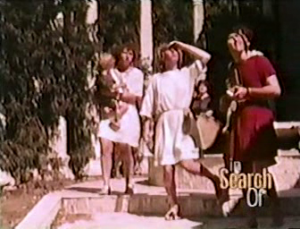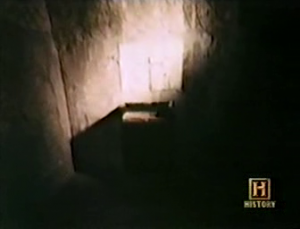In Search Of… S04E10 Pompeii

We open on some re-enactors in tunics playing with a baby in a Roman style sandpit. Sure, why not. There are some columns in the background so, you know, Roman. The people look stupidly into the distance, apparently not recognising the stock footage of volcanic eruptions that is the reverse shot.
Pompeii! Nimoy gives a sweet narration about the eruption, then we get to the big question – is this cross-like object found in the ruins of Pompeii a Christian cross? I’m no archaeologist, but I’m going to go with: “I guess. Maybe. Why not?”
Camera pans across the ruins of Pompeii, while Nimoy waxes lyrical about the grandeur of Rome. It’s a little lacklustre, honestly, as if Nimoy is tired of proclaiming the greatness of one ancient civilization after another.
Some really nice shots of Pompeiian frescos, then a helicopter shot of Vesuvius, and now we’re joining Nimoy by the sandpit in front of the columns. This is some minor producer’s house in Beverly Hills, isn’t it? Again, Nimoy seems slightly uninterested in his grandiose narration, possibly because it contains at least two really obvious factual errors – that there were a ‘thousand’ Egyptian dynasties, and that Pompeii was the farthest city from the Holy Land in distance.
Anyway, point is, Christianity was taking off at the same time as Pompeii went kerflooey.
Talking now to Prof Edward Vendel (?) an expert on Pompeii, who delivers a very lecture-y lecture from the lip of Vesuvius. If I were to transcribe what he said, it would probably read okay, but it’s sooo stilted when he says it. It’s a relief to get back to Nimoy talking about volcanoes and Pompeii over electronic music and a rumbling noise.
There is a three or four second shot of a Roman-style bust, shuddering on a fencepost, and I will now refuse to hear anything against this episode because holy crap that’s funny.

SFX footage of a city crumbling from some movie and… oh no! The bust has fallen off its plinth and cracked on a mosaic floor! Hell, yeah!
There’s a bit from a movie of extras yelling at Roman senators, intercut with In Search Of… actors playing Roman scientists at work with the only apparatus they had — set squares. There’s a clever sequence about an augur reading the entrails of birds, shot so the bird doesn’t die — presumably so the producers can return it to the pet shop for a refund. Sometimes I really love this show. Oh, and then the augur measures a chicken liver with calipers. Delightful!
More shots of Roman-style fountains… Probably the same garden. Extras in tunics and stock footage of volcanoes again. The re-enactors finally stop gawping at the coming darkness and move. A little. Someone drops gravel on a goblet and half a melon. Extras hide. Footage from a big-budget Pompeii movie is cut in, just making the re-enactment look cheaper. Two of the re-enactors are buried under ‘ash’.
And Nimoy is back in a shirt with a collar sooooo wide… He fills a little before we get onto the discovery of the city, and the promise of what might be the first Christian cross.
I’m looking this up now… the cross has been a symbol of Christianity since the second century — so at least a couple of generations after Pompeii. Why wasn’t the cross in use earlier? Again, I’m no expert but the phrase ‘too soon!’ springs to mind.
Prof Vendel lectures some more. Reenactment of an Italian farmer discovering a suspiciously new marble bust in a well he was digging. Shots of tunnels under the city. I’ll say this for In Search Of…, if you like under-lit footage of tunnels, they’ve got you covered. Now footage of the digger finding a broken sign that reads ‘Pompeii’.
Nimoy points out that early explorers were basically just treasure hunters, and scientific study didn’t begin until later. Re-enactor playing Giuseppe Fiorelli figuring out how to make plaster casts of the hollows left by decaying bodies… He seems to be working near that mosaic where the bust shattered. I hope they cleaned this poor guy’s garden later. Anyway, it is quite a well done illustration of Fiorelli’s process, even if the ‘cast’ that they ‘dig up’ is impossibly detailed. This is especially obvious when it’s followed by shots of some of the actual casts with some nicely low-key music and minimal narration. Classy, for once.
Shots now of the interiors of Pompeiian buildings, with Nimoy telling little stories about what is known or suspected to have gone inside them. Nice… Oh God. Here comes Prof Vendel again. Sigh. He sounds like Orson Welles doing an impression of a boring lecturer. But then he explains how wealthy Roman couples didn’t sleep in the same bed because ‘it lead to bad marriages’ and he pauses and gives a little shrug. He’s starting to grow on me.
Nimoy explains disapprovingly about the city’s ‘many lewd murals’. How shocking, let’s watch… Oh. He’s only going with some of the tame ones. 1970s TV, dude. Now Prof Vendel standing in the arena talking about gladiators. The dramatic music and sound of applause contrasts nicely with shots of empty seats.
More frescoes… Four minutes to go, and still no Christianity in Pompeii. We’re talking about Pagan gods… Oh, and now we’re talking about Christianity. The church was only fifty years old when Vesuvius blew. Nimoy says that we wouldn’t expect to see that the faith had spread all the way to Italy.
Wouldn’t we? Why not? The Roman Empire was many things, and one of those things was a massive transportation network. Goods, people and ideas traveled around Roman territory surprisingly quickly. St Paul’s mission to Rome was decades past. In addition, just ten years before Pompeii, there had been massive Roman military operations in Judea, and who knows what returning soldiers might have brought back?
Anyway, we finally move onto the alleged cross. In Herculaneum, not Pompeii, but hey. Interestingly, the ‘cross’ is carved into the stone, rather than being the free-standing cross we might expect to see on a Christian altar. A little research shows that it this cross is now thought to be a the socket where a shelf was stuck into the wall, and that hard evidence of Christian organisation in Pompeii and Herculaneum has yet to be found.
Prof Vendel – a little more animated this time because he’s answering a question rather than speechifying – says that he doubts that the ‘cross’ was an object of Christian worship. He point out that the main symbol of Christianity at the time of Vesuvius’ eruption was the fish. [Insert bumper sticker joke here.] Had there been a fish at the house, he says, he wouldn’t doubt that the occupants were Christian.
Next, we talk to Dr John Ray, a theologian from Anaheim. He says that it looks like a cross, and the depression could have been where a wooden cross was nailed to the wall. He claims it’s “good evidence of a Christian person worshipping.”
All in all, this was a pretty decent episode. As an in-depth look at Pompeii, it’s not great. But as a little taster to get people interested, yeah, you could do worse. The argument over the cross is presumably to add controversy. Honestly, in researching, I was surprised to learn how little evidence there is of Christian worship in Pompeii. I wonder where I got the idea that a Christian presence in Pompeii was not just plausible, but know. Sadly, I think the answer to that is The Last Days of Pompeii, Sir Edward Bulwer-Lytton’s turgid 1834 historical novel, which has Christians all over the place. Somehow I’d assumed that, though it’s a terrible novel, it had a stronger basis in research than it does. A lesson for myself in humility, I guess.
Quote
Prof Vendel: “Pompeii’s place in history is quite unique in that in one day it was completely hermetically sealed. In other words, time… stood… still.”
Overall:
Crappy reenactments: 9/10, Frescoes: 10/10, Lectures: 8/10, Nimoyness: 7/10, Electronic music: 9/10. Overall: 43/50. High Distinction.




